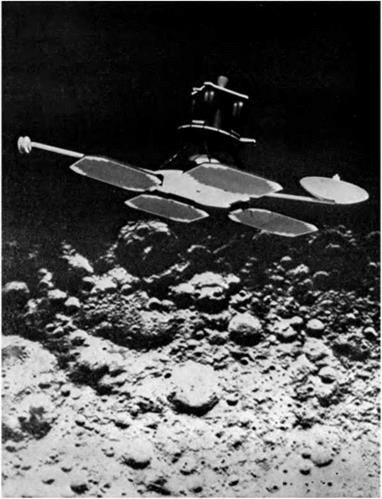Re-entry into the atmosphere
On the Apollo missions, the craft re-entered the atmosphere after at least a partial orbit, and after discarding the larger part of what still remained of the spacecraft leaving only the small command module, a mere 5 tonnes of the 3500 tonnes or more of the mass at launch. From re-entry to splashdown was one of the most difficult, and in some ways the crudest part of the whole procedure. Once again extreme accuracy was needed because the craft, by final
|
|
Fig 13C Orbiting the moon
(By courtesy of the Boeing Company, USA)
Scale model of a lunar orbiter; the lunar landscape (taken by Lunar Orbiter 1 on the far side of the moon) is authentic, and shows the sharp break between sunshine and shadow
use of the rocket power still available, must enter the atmosphere, at some 400 000 feet, through a ‘window’, as it is called, only 8 kilometres wide, and at an angle of between 5.6° and 7.2° to the top of the atmosphere – if it entered too steeply it would have burned up, if too shallowly it would have bounced off again. Not only is the angle of entry very critical, but the craft also had to be manoeuvred into such a position that it encountered maximum drag (from drag rather than skin friction) and so maximum retardation of about 6 g. Even
|
|
Fig 13D Moon landing craft
(By courtesy of the Bell Aerospace Division of Textron Inc, USA) Astronaut Charles Conrad Jr in a lunar landing training vehicle during a simulation flight for the Apollo 12 mission
so, the speed was so high, and the skin friction so great, that the heat generated was quite alarming, the surface of the craft was burnt and scarred, and the air ionised so that radio communication between the earth and the crew was temporarily interrupted. When denser air was reached, first a drogue parachute was released, followed by at least three large parachutes, and these reduced the velocity sufficiently for any surplus fuel to be jettisoned, and finally for a reasonably soft splash-down in the sea, again with reasonable accuracy of position.
In view of the crudeness of this method of approach and landing it is not surprising that a reusable vehicle, the Space Shuttle, was developed (Fig. 13E). This has the same problems – it gets hot and needs to slow down for landing. But using wings gives another way of controlling the trajectory and means that it can land on a runway. It is really a glider – albeit an unusual one!













